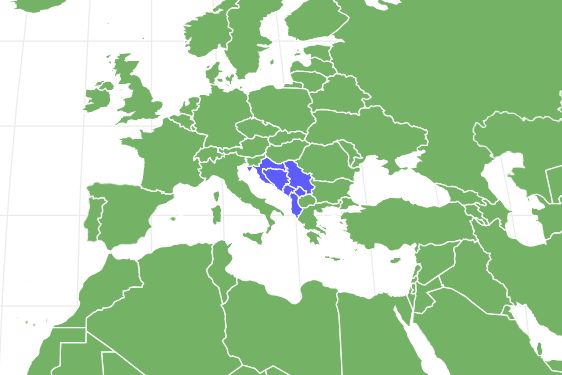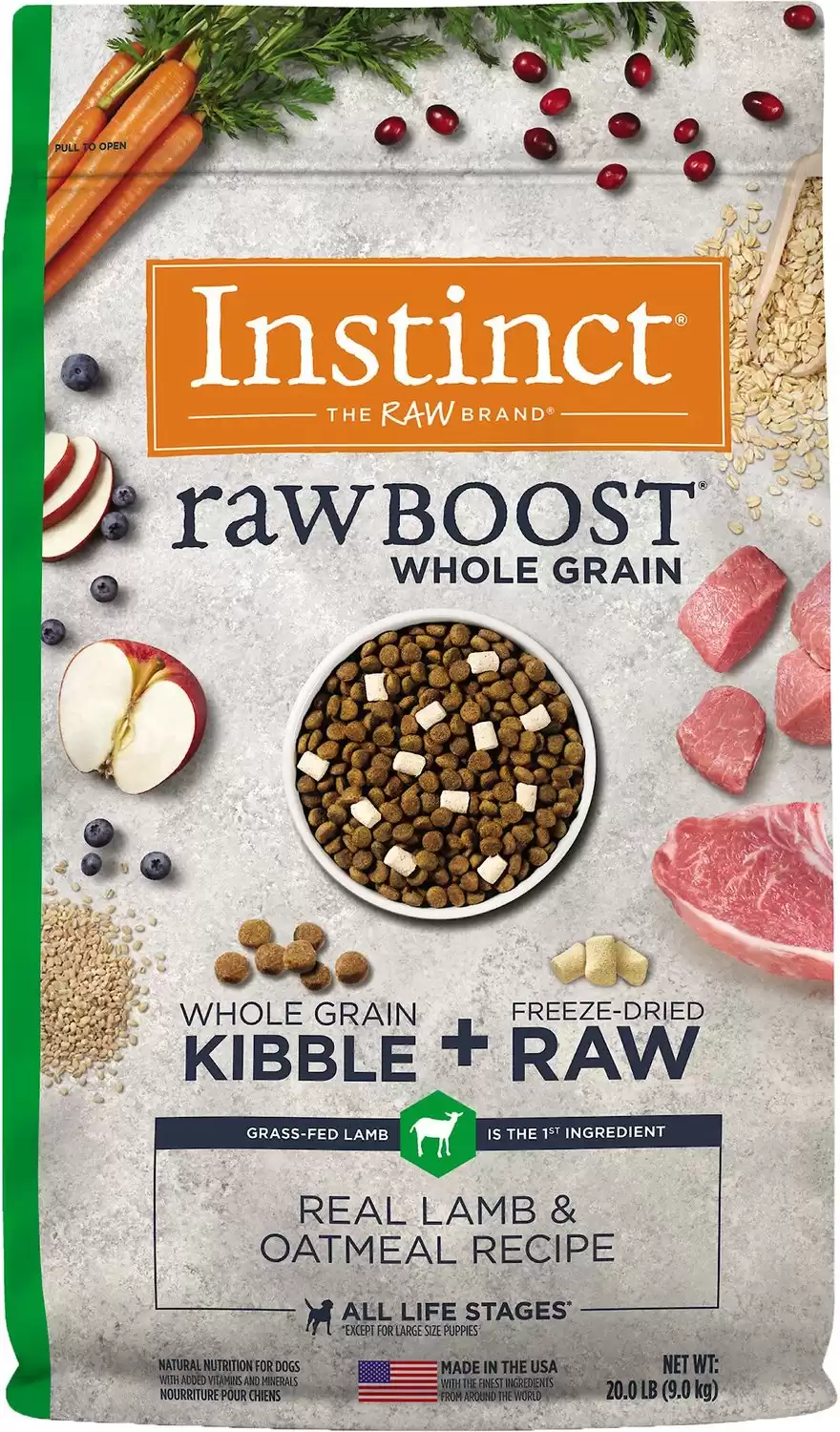Dalmatian
Canis lupus
Dalmatians are used as firehouse mascots
Advertisement
Dalmatian Scientific Classification
- Kingdom
- Animalia
- Phylum
- Chordata
- Class
- Mammalia
- Order
- Carnivora
- Family
- Canidae
- Genus
- Canis
- Scientific Name
- Canis lupus
Read our Complete Guide to Classification of Animals.
Dalmatian Conservation Status
Dalmatian Facts
Dalmatian as a Pet:
- General Health
- Energy Level
- Shedability
- Trainability
- Intelligence
- Tendency to Chew
- Size
- Family and kid friendliness
- Yappiness / Barking
- Low
- Separation Anxiety
- High
- Preferred Temperature
- Warm climate
- Exercise Needs
- Moderate
- Friendly With Other Dogs
- Moderate
- Pure bred cost to own
- $800
- Dog group
- Non-sporting
- Male weight
- 45-60 lbs
- Female weight
- 45-60 lbs
This post may contain affiliate links to our partners like Chewy, Amazon, and others. Purchasing through these helps us further the A-Z Animals mission to educate about the world's species.
View all of the Dalmatian images!
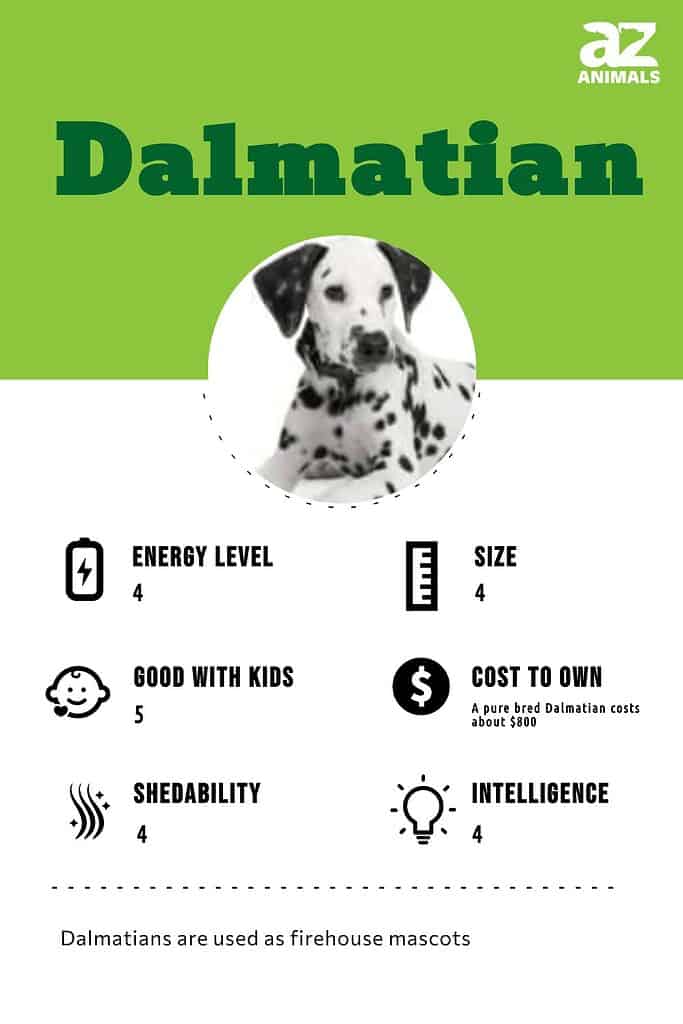
A Dalmatian’s white coat with black spots makes it immediately recognizable. This breed is known for its sensitive temperament and high energy level. It belongs to the non-sporting group.
One of the lesser-known facts about this dog breed is it got its name from a coastal area in Austria called Dalmatia. Descended from pointers, Dalmatians served as coach dogs in 19th century Europe. Coach dogs moved alongside horse-drawn carriages occupied by members of British noble families. Fortunately, Dalmatians were known to get along well with horses!
See all of our expert product reviews.
Today, when people think of a Dalmatian, they may imagine a dog sitting on a fire engine or picture the cast of the Disney movie, ‘101 Dalmatians’.
If you’re looking for a sweet dog with a sensitive temperament that loves to spend time with people, this dog is a great choice!
One of the most amazing facts about the puppies is they are born without spots. Black spots don’t begin to appear on their white coat until they are two weeks old.
You can check out incredible facts about Dalmatians.
3 Pros and Cons of Owning a Dalmatian
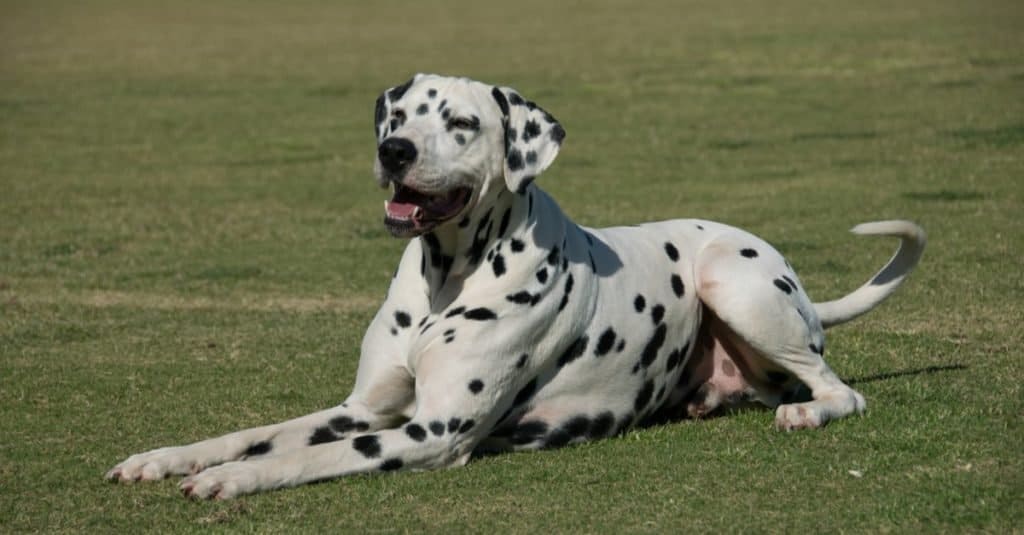
Dalmatians’ ability to get along with horses enabled them to occupy a variety of roles
Health and Entertainment for your Dalmatian
See all of our expert product reviews.
©Peter Wibberley/Shutterstock.com
| Pros! | Cons! |
|---|---|
| A loyal watchdog! Dalmatians are alert dogs that are effective watchdogs for the family home. | Frequent shedding These dogs shed frequently which can result in a lot of vacuuming around the house. |
| Low-maintenance grooming Despite having a beautiful coat, Dalmatians require a very simple grooming routine. | Shyness A Dalmatian that has not been socialized can be shy around unfamiliar people. One of the most important facts to remember is socialization is key to helping them feel more at ease. |
| An energetic nature Dalmatians are high energy dogs, so they make great companions for people who love to get outdoors and run around. | Deafness This breed is prone to deafness. |
Evolution and Origins

Dalmatians once played a key role in the Fire Service
©Timothy Sanders/Shutterstock.com
Named for Dalmatia, a region in Croatia on the Adriatic coast, the canine known for its speckled black-on-white coat has rather disputed origins.
While no one can quite point to its exact origins, it is generally agreed that wealthy English travelers returned with them following a visit to the mainland, in the 1500s.
The breed forever immortalized in pop culture thanks to Disney’s “101 Dalmatians”, soon became the hound of choice for the wealthy being driven about in carriages, serving as miniature polka-dotted bodyguards.
Due to their ability to get along with horses, they also served as the canine equivalent of sirens to announce fire fighting carriages, protect the horses which drew them, and serve as a calming influence on their equine friends amid all the chaos, smoke, and ash.
Long after carriages were replaced by automobiles, these faithful, intelligent canines, continued to be given a position of honor in the fire service, in memory of the key role they once played.
Size and Weight
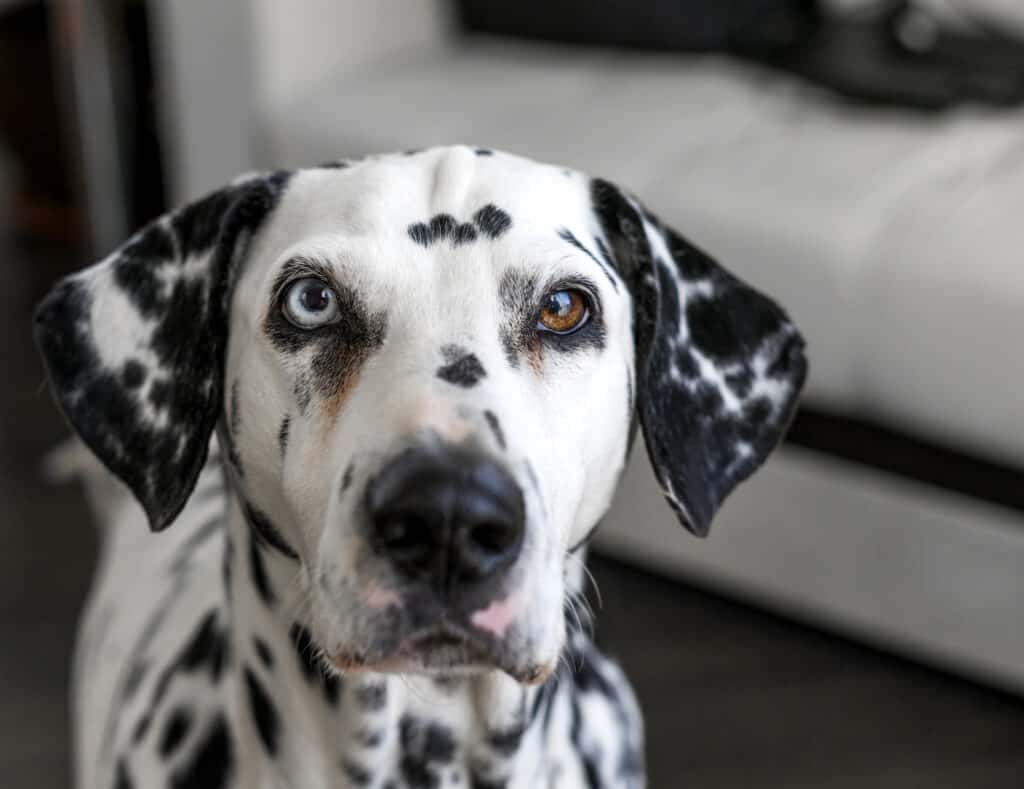
Dalmatians reach their full size at 16 months with males being slightly larger than females, but both genders weighing the same
©iStock.com/Eugen Fedorov
These dogs are medium size dogs. Males can grow to be 23 inches tall at the shoulder while females grow as tall as 22 inches. Both males and females weigh 60 pounds fully grown. At seven weeks old, puppies weigh around 12 pounds. They are fully grown at 16 months.
| Height (Male) | 23’ Tall |
| Height (Female) | 22’ Tall |
| Weight (Male) | 60 lbs, fully grown |
| Weight (Female) | 60 lbs, fully grown |
Common Health Issues

Dalmatians are prone to bladder stones and copper hepatopathy
©iStock.com/animalinfo
Like any other breed of dog, Dalmatians are prone to some health issues. One of those issues is deafness. Deafness can be passed down through the bloodline. Another common health issue is bladder stones. A Dalmatian that seems to be in pain as it relieves itself may be suffering from this condition and should be taken to a vet.
A third common health issue of this breed is a liver disorder known as Copper hepatopathy. This is a high level of copper in a dog’s liver. Yellow eyes and gums are two signs of this disorder. It usually appears in dogs between ages 2 and 4. Obesity is another common health issue for them. These dogs need daily exercise and a balanced diet to avoid obesity.
The most common health issues of this dog breed include:
- Deafness
- Bladder stones
- Copper hepatopathy (liver disorder)
- Obesity
Temperament
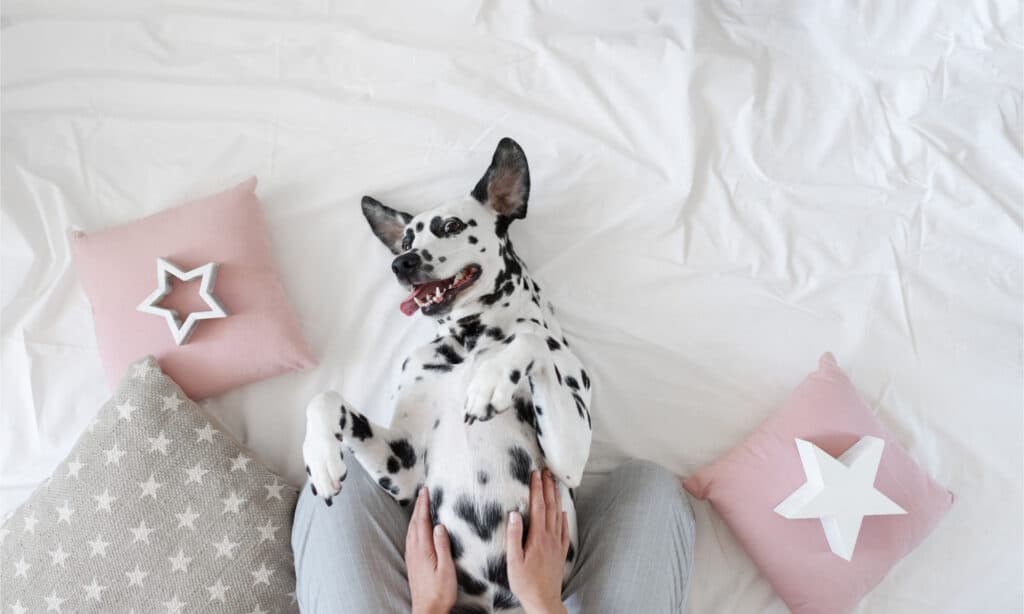
Dalmatians are known for being affectionate and playful. However, they must be socialized early as puppies
©RavenaJuly/Shutterstock.com
These dogs have a sensitive temperament. They are known for their sweet, playful personality. Though these dogs are good with kids, they should be monitored around particularly small children. When these high-energy canines start to run around, they can knock a small child down without meaning any harm.
One of the most notable traits of this breed is loyalty. They like to spend time around their owner and family.
It’s important to socialize puppies so they become accustomed to interacting with people and other dogs. They’re prone to shy behavior unless they’re socialized early on.
How to Take Care of Dalmatians
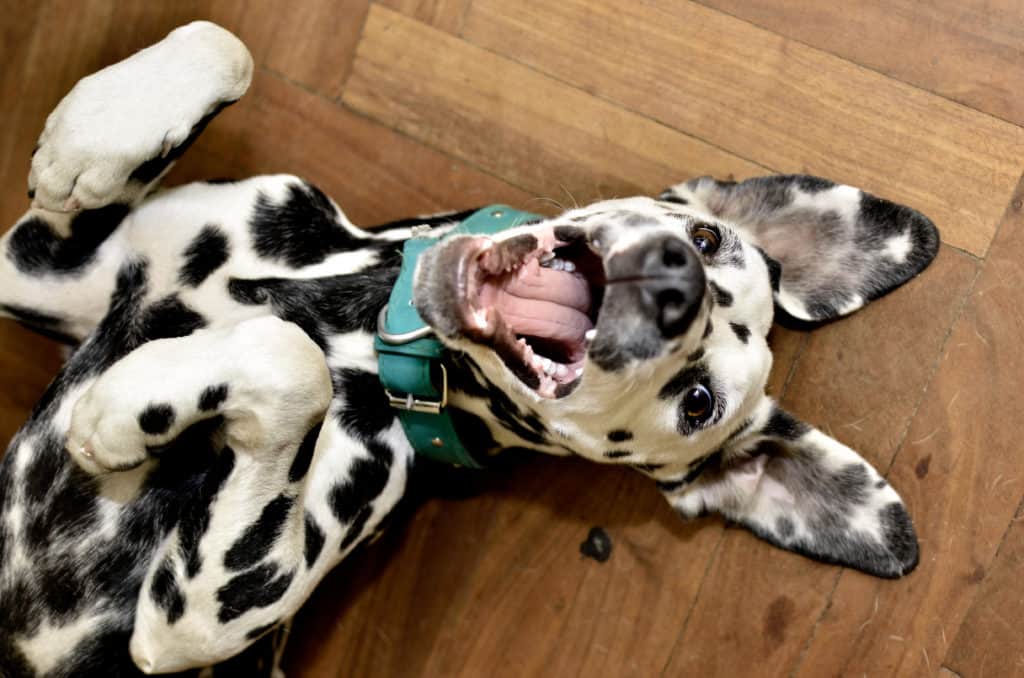
Like all breeds Dalmatians have a specific set of needs with regard to diet, exercise, and healthcare
©patostudio/Shutterstock.com
Whether you get a puppy or an adult dog, learning as much as you can about the diet, exercise, and healthcare needs of these dogs can help you to give your pet the proper care.
The Best Dog Food for Dalmatians
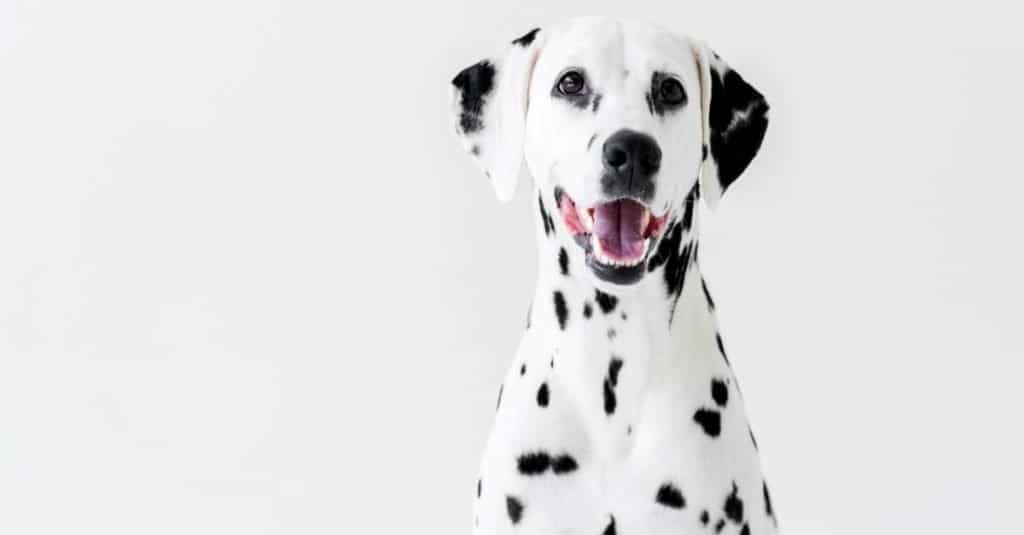
Dalmatians will thrive best on a low-purine diet to lower the risk of bladder stones
©LightField Studios/Shutterstock.com
Importantly, puppies and adult dogs have different dietary needs. Fortunately, living them the proper nutrition can prevent some health issues and keep them in great condition for years to come. Therefore, consider these factors for puppies and adults.
Dalmatian puppy food: Food for a Dalmatian puppy should contain high-quality protein. Primarily, protein helps to build strong bones and muscles. Purine can change into uric acid which causes bladder stones in Dalmatians. Also, look for Omega-6 fatty acids that contribute to the development of a puppy’s brain and eyes. Fiber is an ingredient that helps with a puppy’s digestion and calcium helps with teeth development. Antioxidants contribute to the health of a puppy’s immune system. Avoid foods with fillers such as corn and wheat that unnecessarily add to a puppy’s weight.
Dalmatian adult dog food: A diet with a low level of purine (or none) is just as important for adult Dalmatians as it is for puppies. Along with high-quality protein, an adult Dalmatian needs food with a mix of DHA and EPA to support the health of their heart. Additionally, antioxidants support an adult dog’s immune system and can prevent arthritis. Also, food low in saturated fat can help an adult Dalmatian maintain a healthy weight and avoid obesity. Finally, calcium in the dog’s diet supports the health of bones, skin, and teeth.
Most importantly, Dalmation owners should prioritize a high-protein formula for healthy body weight.
With this in mind, A-Z Animals says the best dog food for Dalmations is Instinct Raw Boost Whole Grain Dry Dog Food, Natural Kibble with Omegas + Freeze Dried Raw Dog Food.
Firstly, the freeze-dried, raw boost of healthy protein from lamb, fish, and beef is less processed and more nutritious. As a result, your Dalmation will know when it’s full and be less likely to overeat and gain too much weight. As opposed to regular kibble, the raw kibble retains more natural flavors, antioxidants, amino acids & vitamins, and minerals, in addition to being high-protein.
Check Chewy and Amazon for this product.
- High protein dog food mixed with freeze dried raw toppers
- Contains probiotics for healthy digestion and omegas for skin & coat
- No corn, wheat, soy, potato, peas, lentils, by-product meal, artificial colors or preservatives.
Maintenance and Grooming
How much do Dalmatians shed? Dalmatians are known as frequent shedders. However, grooming a Dalmatian on a weekly basis can get rid of a lot of loose hair.
A rubber curry comb is an effective grooming tool for removing loose and dead hair. A rubber grooming mitt can gently go over the dog’s legs. Always brush your dog starting at its head and ending with its tail so you’re moving in the natural direction of the hair.
The dog’s nails need clipping once a month and owners should clean the underside of its ears with a soft cloth. Use a mild cleanser to clean the sensitive skin on a dog’s ears. If you’re not sure how to trim your dog’s nails or properly clean its ears, be sure to find guidance from your veterinarian.
Grooming your dog weekly not only keeps its coat in good condition but also gives you the opportunity to check for skin irritation or hair loss. Red or scaly skin can be a sign of an allergy and should be checked by a vet.
The Dog’s Training
Dalmatians are relatively simple to train because they are alert and eager to please. The fact that a Dalmatian has a sensitive temperament means it’s best to use treats and words of praise throughout training sessions. Though very different in size, an Italian greyhound is another example of a high energy dog with a sensitive temperament.
Exercise
Dalmatians have a lot of energy. Giving them 30 to 60 minutes of exercise per day helps them to maintain good physical and mental health. Unfortunately, a Dalmatian that doesn’t get enough exercise is prone to obesity and can start to become destructive.
These dogs love activities of all kinds. They enjoy running, chasing a ball, jogging around a field, and playing hide and seek.
If a Dalmatian has socialized from an early age, it can be taken to a dog park to mix with other dogs.
A Dalmatian is not a good choice for someone living in an apartment. This canine needs lots of space for running with its owner. Ideally, it needs a home with a fenced-in yard.
Puppies

Special care must be taken to feed Dalmatian puppies a low-purine diet
©Veda Wildfire/Shutterstock.com
When it comes to Dalmatian puppies, the biggest thing to keep in mind is to feed them a diet that has a very low amount of purine.
Children
Dalmatians are known to be good with children. But Dalmatian puppies are particularly rambunctious when at play. So, it’s best to keep an eye on them when they are around very small children who can fall over easily.
Dogs Similar to Dalmatians
Dogs similar to the Dalmatian include the English pointer, border collie, and boxer.
- English pointer – Dalmatians are descendants of pointers, so they share a mix of DNA. Dalmatians and English pointers are about the same height and weight. They also share a playful, loyal temperament.
- Border collie – Border collies have a sensitive temperament and are high energy as well.
- Boxer – Like Dalmatians, boxers are high energy dogs that love to run and play. They are also excellent watchdogs and loyal to their owners.
Famous Dalmatians
Famous Dalmatians? You bet! These dogs are well-known in many areas of our culture and history.
- Dalmatians have been connected with firehouses for over a century. The role of these dogs was to run in front of the horse-drawn fire carriages in order to clear the way to a fire. Today, they are still kept in some firehouses as mascots.
- President George Washington was an avid dog breeder and a fan of Dalmatians.
- The Disney movie 101 Dalmatians featured these beautiful puppies.
Popular Names for Dalmatian Dogs
Popular names for these dogs include:
- Ace
- Bingo
- Coach
- Freckles
- George
- Pongo
- Pepper
- Wags
Dalmatian FAQs (Frequently Asked Questions)
Are Dalmatians herbivores, carnivores, or omnivores?
Dalmatians are Omnivores, meaning they eat both plants and other animals.
What Kingdom do Dalmatians belong to?
Dalmatians belong to the Kingdom Animalia.
What class do Dalmatians belong to?
Dalmatians belong to the class Mammalia.
What phylum to Dalmatians belong to?
Dalmatians belong to the phylum Chordata.
What family do Dalmatians belong to?
Dalmatians belong to the family Canidae.
What order do Dalmatians belong to?
Dalmatians belong to the order Carnivora.
What genus do Dalmatians belong to?
Dalmatians belong to the genus Canis.
What type of covering do Dalmatians have?
Dalmatians are covered in hair.
How much does it cost to own a Dalmatian?
The initial purchase price of a Dalmatian is around $800. Veterinary costs for a Dalmatian range from $300 to $500 per year. Vet costs vary depending on what services your dog needs and the price of each service.
Food costs for a Dalmatian range from $50 to $150 a month. Once again, the price of food varies depending on the brand and how much you purchase.
Are Dalmatians good with kids?
When Dalmatians are socialized from puppyhood, they are known to be good with children.
How long do Dalmatians live?
The lifespan of a Dalmatian is 12 to 14 years.
What is the best dog food for a Dalmatian?
The best dog food for Dalmatians contains high-quality protein that leaves out purine. Purine can cause bladder stones. Other beneficial ingredients include calcium, Omega-6 fatty acids, antioxidants, and fiber.
Is a Dalmatian a good family dog?
Yes, Dalmatians are good family dogs. They are sensitive, loyal, and playful.
What is the life expectancy of a Dalmatian?
Dalmatians can live to be around 14 years old.
Do Dalmatians bark a lot?
No. They save their barking for appropriate occasions.
Why is a Dalmatian called a firehouse dog?
More than a century ago, Dalmatians were used by fire crews to run in front of the horse-drawn fire carriage to clear people and animals out of its way. Remember Dalmatians were used as coach dogs?
With today’s modern firetrucks Dalmatians no longer have to clear the way, but they are still seen at firehouses as companions for the fire crew as well as mascots.
What is an interesting fact about Dalmatians?
Dalmatians have an energetic and playful nature!
What is the scientific name for the Dalmatian?
The scientific name for the Dalmatian is Canis lupus.
What are the differences between a Dalmatian and a Great Dane?
The key differences between Dalmatians and Great Danes are size, appearance, temperament, and life expectancy. Although Dalmatians and Great Danes share a similar build, both breeds are easily distinguishable. These two breeds do not belong to the same breed group and have numerous variances. Dalmatians, for example, belong to the non-sporting group, but Great Danes belong to the working group.
Thank you for reading! Have some feedback for us? Contact the AZ Animals editorial team.
Sources
- American Kennel Club, Available here: https://www.akc.org/dog-breeds/dalmatian/
- Vetstreet, Available here: http://www.vetstreet.com/dogs/dalmatian
- Wagwalking, Available here: https://wagwalking.com/breed/dalmatian

